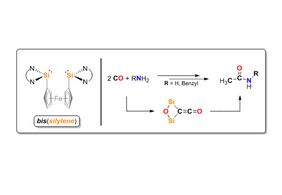The activation and coupling of small molecules offers a new strategy to synthesize organic commodities (hydrocarbons, alcohols, ketones, carbonic acids etc.) and fine chemicals. The bottom-up synthesis of heteroatom containing organic molecules, such as amines, amides and cyanides from carbon oxides and ammonia as simple building blocks is of particular interest.
Matthias Driess and his co-workers from the Technische Universität Berlin, Germany, report on a silicon-mediated direct coupling of carbon monoxide, ammonia and primary amines to form acetamides which are central in organic chemistry and physiology. The transformation starts with the deoxygenative homocoupling of two CO molecules at two coperative divalent silicon atoms in a bis(silylene) to give a disilaketene. The latter undergoes facile ammonolysis affording the respective acetamide and disilyldiamide.
A closer look into the reaction mechanism revealed that four steps are needed to stepwise perform this transformation. The authors show that the reaction is initiated by the formation of a silylated carboxamide and could experimentally observe further key intermediates. The team also carried out computational studies to understand the strikingly facile bond cleavage.
For further information on the ChemViews Highlight see ChemViews.org
Silicon‐Mediated Coupling of Carbon Monoxide, Ammonia, and Primary Amines to Form Acetamides
M.-P. Luecke, A. Kostenko, Y. Wang, S. Yao, M. Driess
Angewandte Chemie International Edition, DOI: 10.1002/anie.201904361
Reprinted with permission. Copyright 2019 John Wiley & Sons, Inc.



